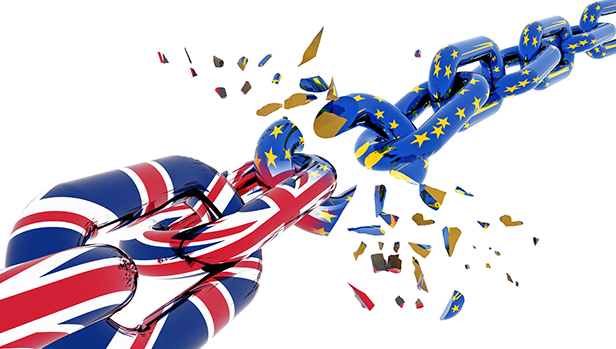
More than three years after the U.K. voted to leave the European Union(EU), it has accomplished that goal. On Friday, January 31, atmidnight CET, the U.K.'s exit became a reality through a structuredwithdrawal agreement. While attention now turns to the future, theU.K.'s departure is bringing difficulties to the nation'sbusinesses in the near term.
|Now that the Brexit date has passed, the U.K. can begin tonegotiate new trade agreements in earnest. The most important ofthese will define the country's future trading relationship withthe EU. Current U.K.-EU trading arrangements remain in place onlyuntil December 31, 2020. This short timeline makes it likely thatthe deal reached this year will be limited in scope, which couldpotentially spell a painful adjustment in 2021.
|Worse, should the two parties fail to negotiate a tradingagreement by the end of the transition period, they risk fallingback on World Trade Organization (WTO) rules. The pressures on theeconomic environment and the underlying uncertainties continue totake a toll across U.K. and EU markets.
|The long period of uncertainty has created a climate of negativesentiment, and this may persist throughout the year in the absenceof details about the U.K.'s future trading relationship with theEU. After stagnating in 2019, U.K. business investment will likelystay flat again this year amid low confidence and high uncertainty.U.K. economic growth is forecast to slow to a meager 1 percent in2020, cushioned to some extent by fiscal and monetary support fromcentral bank sources. Many businesses have already been debilitated by the volatile conditions plaguingthe British economy since the 2016 referendum. These companiesremain at significant risk of insolvency.
||
Business Insolvencies Are Increasing in theU.K.
Insolvencies can be expected to increase among U.K. companies.They have been growing significantly since 2018, increasing 8percent year-on-year in 2019, and we expect another increase of 7percent or more in 2020.
|The retail sector continues to face bankruptcies due to lowerconsumer confidence and the changing dynamics within the sector.Heavily dependent on seasonal opportunity, retailers often look toDecember sales to bolster performance. However, total annualizedretail sales fell in November and December 2019, according toindustry body British Retail Consortium.
|For British sectors dependent on imports—food and agriculture,in particular—Brexit remains a factor. These businesses maystruggle to absorb any higher import and logistics costs thatresult from the separation.
|The U.K. construction sector is already challenged by weakinvestment. The prospective loss of skilled labor from EU nationalswho can no longer work in the U.K. is creating risk forconstruction companies, which may have to increase costs in orderto attract workers. These factors may further elevate the risk ofinsolvency in the sector.
||
Downside Risks Increasing in the EU
At the same time, we expect to see a rise in business failuresthroughout most of Europe, albeit at a rate lower than in the U.K.The countries with the closest trading ties to the U.K.—such asIreland—are at higher risk. Insolvencies in Belgium, theNetherlands, Denmark, and other important trading partners arelikely to be visible but more limited. That said, the businessclimate remains volatile across Europe and the overall risk ofbusiness failures is rising.
|Industry sectors that rely heavily on exports to the U.K., suchas automotive, textiles, and high-tech goods, can be expected toexperience more significant impacts. Still, individual businessescontinue to report successes in certain markets.
||
How Foreign Companies Can Mitigate theRisks
There is an opportunity for trade growth, both during and beyondthe transition period. Most of these opportunities lie in marketsoutside the EU, as the U.K. negotiates direct trade deals withcountries such as the United States, where previously, negotiationswould have occurred at the EU level. In addition, now that the U.K.can set its own regulations in areas such as manufacturing, it maybe able to amend certain working directives that ultimately willprovide a competitive advantage over EU businesses.
|One of the keys to success will be a robust risk managementstrategy that combines access to reliable business intelligencewith specific risk mitigations tools. Tradecredit insurers, for instance, closely monitor insolvency trendsand offer financial protection to provide peace of mind throughoutthe lifecycle of a trade relationship.
|
 David Culotta, CFA,is the senior manager of U.S. buyer underwriting forAtradius Trade Credit Insurance Inc. located in HuntValley, Maryland. In this role, he is responsible for providingstrategic direction for the U.S. underwriting platform and formonitoring the development of the U.S. portfolio and adapting therisk management approach as necessary. Culotta earned his MBA atLoyola University Maryland and is a CFA charterholder.
David Culotta, CFA,is the senior manager of U.S. buyer underwriting forAtradius Trade Credit Insurance Inc. located in HuntValley, Maryland. In this role, he is responsible for providingstrategic direction for the U.S. underwriting platform and formonitoring the development of the U.S. portfolio and adapting therisk management approach as necessary. Culotta earned his MBA atLoyola University Maryland and is a CFA charterholder.
Complete your profile to continue reading and get FREE access to Treasury & Risk, part of your ALM digital membership.
Your access to unlimited Treasury & Risk content isn’t changing.
Once you are an ALM digital member, you’ll receive:
- Critical Treasury & Risk information including in-depth analysis of treasury and finance best practices, case studies with corporate innovators, informative newsletters, educational webcasts and videos, and resources from industry leaders.
- Exclusive discounts on ALM and Treasury & Risk events.
- Access to other award-winning ALM websites including PropertyCasualty360.com and Law.com.
*May exclude premium content
Already have an account? Sign In
© 2024 ALM Global, LLC, All Rights Reserved. Request academic re-use from www.copyright.com. All other uses, submit a request to [email protected]. For more information visit Asset & Logo Licensing.







